Welcome to our free classical music site

Do you write about classical music? Are you a blogger? Want to team up with Classical Connect? Send us a message, let's talk!

Do you write about classical music? Are you a blogger? Want to team up with Classical Connect? Send us a message, let's talk!
October 30, 2017. An old picture. Last week, as we were looking for a good photograph of Emil Gilels, we came across this picture. It was taken during the May 1 celebrations in 1940; in it are six young musicians, all of great talent, aged 17 to 27. Young, happy, Jewish (those were the last pre-Antisemitic days of the Soviet Union), they are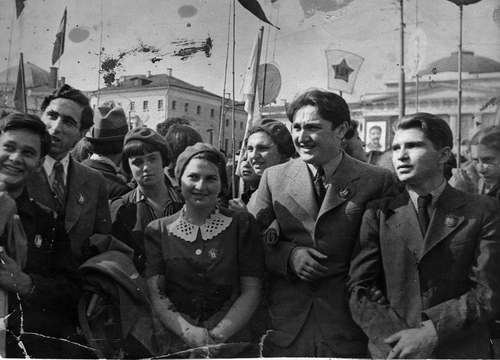 standing in a crowd on the Manezh Square, just outside of the Kremlin (behind them is Moscow University), smiling. 1940 was the year between two catastrophes, that of the Great Terror of 1937-38 and the war with Germany, which would invade the Soviet Union in a year. But in the meantime, they were living a rather privileged life: they made the young Soviet state proud, and the state responded with honors and good apartments. Who are they? Let’s start on the left and moveright. On the left is the youngest of them all, Busya (Boris) Goldshtein at 17. A violinist and a child prodigy, he was in in Odessa, and studied with Pyotr Stolyarsky. When Jascha Heifetz visited the Soviet Union in 1934, he met with many young violinists and singled Busya out. In 1935, at age 12 and a half, he won the fourth prize at the Henryk Wieniawski Violin Competition in Warsaw (Ginette Neveu was first, David Oystrakh came in second). Two years later, still not even 15, he received the fourth prize at the first Ysaye Competition in Brussels. During the war, being a student of the Moscow Conservatory, he, as many other musicians performed at the front line. This prevented him from timely passing the exam on a very important subject, “Brief History of the Communist Party.” So, despite his fame and honors, he was expelled from the Conservatory, which for all purposes was the end of his career. Goldstein emigrated to Germany in 1972 but never regained the status he held while a teenager.
standing in a crowd on the Manezh Square, just outside of the Kremlin (behind them is Moscow University), smiling. 1940 was the year between two catastrophes, that of the Great Terror of 1937-38 and the war with Germany, which would invade the Soviet Union in a year. But in the meantime, they were living a rather privileged life: they made the young Soviet state proud, and the state responded with honors and good apartments. Who are they? Let’s start on the left and moveright. On the left is the youngest of them all, Busya (Boris) Goldshtein at 17. A violinist and a child prodigy, he was in in Odessa, and studied with Pyotr Stolyarsky. When Jascha Heifetz visited the Soviet Union in 1934, he met with many young violinists and singled Busya out. In 1935, at age 12 and a half, he won the fourth prize at the Henryk Wieniawski Violin Competition in Warsaw (Ginette Neveu was first, David Oystrakh came in second). Two years later, still not even 15, he received the fourth prize at the first Ysaye Competition in Brussels. During the war, being a student of the Moscow Conservatory, he, as many other musicians performed at the front line. This prevented him from timely passing the exam on a very important subject, “Brief History of the Communist Party.” So, despite his fame and honors, he was expelled from the Conservatory, which for all purposes was the end of his career. Goldstein emigrated to Germany in 1972 but never regained the status he held while a teenager.
Next to him stands the pianist Yakov Flier, at 27 the eldest. Flier was born on October 21st, 1912, in Orekhovo-Zuyevo, a town outside of Moscow famous for its textile production but not its culture. Not at all a wunderkind, his talent developed slowly. After attending the Central music school, he was accepted at the Conservatory and studied there with one of the best professors, Konstantin Igumnov. He reached his full potential only by the end of his studies, but once at the top, he remained at the top as long as he could play. Starting 1935, he embarked on a series of concerts across the Soviet Union. In 1936 he won a piano competition in Vienna, ahead of his friend Emil Gilels, who took the second prize. Gilels would have his revenge two years later in Brussles, where he won the Ysaye while Flier was “only” the third. As early as in 1945 Flier noticed problems with his right hand; it was getting worse and by 1949 Flier could no longer play. He was absent from the concert scene for 10 years but returned in 1959 after a successful surgery and rehabilitation. While his earlier playing was romantic, sometimes too much so, it became deeper and more introspective. In 1960s and the 70s he toured in Europe and the US and became one of the most sought-after professors of the Moscow Conservatory.
Next to Flier, a step behind, stands the 18-year-old Rosa Tamarkina, fresh from a triumph at the Chopin competition. Why is she standing next to Flier, and not to Emil Gilels, whose wife she would become later that year? Is she still infatuated with Flier, as was rumored in Moscow? Why didn’t she marry him, one wonders – her marriage to Gilels was not very happy and brief, as, tragically, was her life. We’ll have to wait till next week to conclude our story about this remarkable group.Permalink
October 23, 2017. Emil Gilels. Last week we intended to write about the great Russian pianist, Emil Gilels but ran out of space. This week, even though we have several very interesting anniversaries, we’ll start with him. Emil Gilels was born in Odessa on October 19th of 1916. At that time, the musical Odessa was an amazing place. The whole school of violin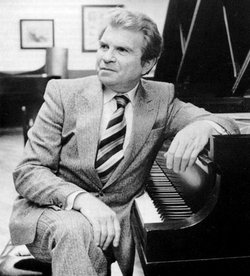 playing came out of Odessa: Pyotr Stolyarsky established it, and among his students were David Oistrakh, Nathan Milstein, Boris Goldstein, and Emil’s sister, Elizabeth Gilels. The pianists Benno Moiseiwitsch, Vladimir de Pachmann, Shura Cherkassky, Yakov Zak were all from Odessa. Sviatoslav Richter, though not born in Odessa, studied there. As most of the Odessa musicians, Emil Gilels was born into a Jewish family. His first teacher, at the age of five and a half, was Yakov Tkach (who, as Gilels acknowledged later, built the foundation of the pianist’s prodigious technique). Emil gave his first public concert at the age of 12. In 1930, not quite 14, he was accepted into the Odessa Conservatory, class of Berta Reingbald, whose other star pupil was Tatiana Goldfarb. In 1932 he met Arthur Rubinstein, who was visiting Odessa, and they became friends, even though Rubinstein was almost 30 years older. In 1933 Gilels won the first All-Union Performers’ Competition in Moscow and became famous overnight. He graduated from the Odessa Conservatory in 1935 and for the following three years studied with Heinrich Neuhaus in Moscow. He won several piano competitions, including the Concours Eugène Ysaÿe, Brussels, in 1938, and established himself as one of the most brilliant young pianists in the Soviet Union. Sergei Rachmaninov, then in the States, had heard about Gilels since his win in Moscow in 1933. After Brussels, many of Gilels’s performances were recorded, and Rachmaninov could listen to them on the radio. He decided that Gilels was his worthy successor, and sent him the Anton Rubinstein medal, which he received upon graduating from the Conservatory, and his Conservatory diploma. Gilels cherished these gifts for the rest of his life.
playing came out of Odessa: Pyotr Stolyarsky established it, and among his students were David Oistrakh, Nathan Milstein, Boris Goldstein, and Emil’s sister, Elizabeth Gilels. The pianists Benno Moiseiwitsch, Vladimir de Pachmann, Shura Cherkassky, Yakov Zak were all from Odessa. Sviatoslav Richter, though not born in Odessa, studied there. As most of the Odessa musicians, Emil Gilels was born into a Jewish family. His first teacher, at the age of five and a half, was Yakov Tkach (who, as Gilels acknowledged later, built the foundation of the pianist’s prodigious technique). Emil gave his first public concert at the age of 12. In 1930, not quite 14, he was accepted into the Odessa Conservatory, class of Berta Reingbald, whose other star pupil was Tatiana Goldfarb. In 1932 he met Arthur Rubinstein, who was visiting Odessa, and they became friends, even though Rubinstein was almost 30 years older. In 1933 Gilels won the first All-Union Performers’ Competition in Moscow and became famous overnight. He graduated from the Odessa Conservatory in 1935 and for the following three years studied with Heinrich Neuhaus in Moscow. He won several piano competitions, including the Concours Eugène Ysaÿe, Brussels, in 1938, and established himself as one of the most brilliant young pianists in the Soviet Union. Sergei Rachmaninov, then in the States, had heard about Gilels since his win in Moscow in 1933. After Brussels, many of Gilels’s performances were recorded, and Rachmaninov could listen to them on the radio. He decided that Gilels was his worthy successor, and sent him the Anton Rubinstein medal, which he received upon graduating from the Conservatory, and his Conservatory diploma. Gilels cherished these gifts for the rest of his life.
During WWII Gilels performed for the troops and, in 1944, premiered Prokofiev’s 8th piano sonata. In 1945, he formed a highly successful trio with Leonid Kogan (his brother in law – Kogan married his sister, the violinist Elizabeth) and the 23-year old Mstislav Rostropovich. After the war he became one of the first Soviet musicians to be allowed to travel and perform abroad (David Oistrach was another pioneer). Gilels played his American debut at the Carnegie Hall in October of 1955. Eugene Ormandy conducted the Philadelphia Orchestra. The performance of Tchaikovsky’s First Piano concerto was a triumph (both Rachmaninov and Horowitz also chose this concerto for their debuts). The rest of his US tour was equally successful. He returned to the States several times, and was always received equally well. Gilels was permitted to travel to other Western countries, a privilege not afforded to many Soviet musicians. He toured all over Europe and Japan playing with the greatest orchestras and conductors. Still, in the centralized Soviet Union, where everything had to be ranked, he was considered to be second to Sviatoslav Richter, as Kogan was considered second to Oistrakh, or Danill Shafran – to Rostropovich. These comparisons of course are nonsense, Gilels was second to no one, he was one of the greatest pianists of the 20th century. In 1981, after a concert at the Concertgebouw in Amsterdam Gilels suffered a heart attack. He never fully recovered and died on October 14th of 1985 in Moscow.
Gilels’s repertoire was phenomenally broad. He played “everything.” He was considered one of the greatest interpreters of Prokofiev’s piano sonatas. He recorded all of Beethoven’s piano concertos seven times. His Mozart was incomparable. Out of this treasure trove we’ll play just two sonatas of Domenico Scarlatti – and that’s because Scarlatti was also born this week, on October 26th of 1685. Here’s his sonata Sonata K.141, and here – Sonata K.533. Both were recorded live in London in 1957.Permalink
October 16, 2017. Galuppi. Franz Liszt was born this week and so was Charles Ives, but we’ve written about both extensively in the past. Luca Marenzio, a wonderful Italian madrigalist of the late Renaissance was also born this week, we celebrated him a year ago (here is his Là dove sono i pargoletti Amori, performed by Concerto Italiano, Rinaldo Alessandrini conducting). We’ve never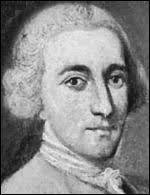 written about Baldassare Galuppi, though, and while he’s not one of the greats, he composed some very interesting music. Galuppi was born on October 18th of 1706 in Burano, an island in the Venetian lagoon almost as famous for its lace-making as Murano, an island nearby, is for its glass. Galuppi took music lessons with Antonio Lotti, the organist at San Marco. As a teenager he wrote an unsuccessful opera and at the age of 20 left Venice for Florence to work as a cembalist at the Teatro della Pergola. He returned to Venice in 1728 and continued composing and performing, although still without much success. In Venice of the time, Antonio Vivaldi ruled over the musical scene, and as for operas, Neapolitan productions were in vogue. In 1740 Galuppi was appointed the music director at the Ospedale dei Mendicanti, run by the Mendicanti friars. Mendicanti was an important institution, not just a hospital but also a school (especially for abandoned girls) and a shelter for lepers. Antonio Vivaldi’s father taught music there some years earlier. Galuppi’s responsibilities included teaching and composing. Less than a year into the contract with Mendicanti, Galuppi asked for permission to go to London. He stayed there for a year and a half and produced 11 operas, three of them his own. Apparently, Handel visited some of Galuppi’s productions. He returned to Venice in 1743; he continued composing operas, but his style was changing: in addition to opera seria (serious opera), in which he often cooperated with the famous librettist Metastasio, he tried himself in the new Dramma giocoso, (“drama with jokes”), the “new and improved” comic opera buffa. His new operas were more successful; Galuppi was also advancing professionally – in 1748 he was made the vice-maestro at San Marco. An even more consequential event took place a year later, when Galuppi started his collaboration with Carlo Goldoni, the famous playwright and librettist. In May of 1749, Galuppi wrote Arcadia in Brenta on Goldoni’ libretto. It was a big success, and by the end of the same year, they produced four more operas. Altogether, Galuppi and Goldoni created 18 more. Galuppi was so busy that he had to resign from Mendicanti. By the middle of the 1750s he was the most popular opera composer in all of Europe (Rameau and Gluck were probably very envious). In 1762, Galuppi was made maestro di capella of San Marco, the most important musical position in Venice.
written about Baldassare Galuppi, though, and while he’s not one of the greats, he composed some very interesting music. Galuppi was born on October 18th of 1706 in Burano, an island in the Venetian lagoon almost as famous for its lace-making as Murano, an island nearby, is for its glass. Galuppi took music lessons with Antonio Lotti, the organist at San Marco. As a teenager he wrote an unsuccessful opera and at the age of 20 left Venice for Florence to work as a cembalist at the Teatro della Pergola. He returned to Venice in 1728 and continued composing and performing, although still without much success. In Venice of the time, Antonio Vivaldi ruled over the musical scene, and as for operas, Neapolitan productions were in vogue. In 1740 Galuppi was appointed the music director at the Ospedale dei Mendicanti, run by the Mendicanti friars. Mendicanti was an important institution, not just a hospital but also a school (especially for abandoned girls) and a shelter for lepers. Antonio Vivaldi’s father taught music there some years earlier. Galuppi’s responsibilities included teaching and composing. Less than a year into the contract with Mendicanti, Galuppi asked for permission to go to London. He stayed there for a year and a half and produced 11 operas, three of them his own. Apparently, Handel visited some of Galuppi’s productions. He returned to Venice in 1743; he continued composing operas, but his style was changing: in addition to opera seria (serious opera), in which he often cooperated with the famous librettist Metastasio, he tried himself in the new Dramma giocoso, (“drama with jokes”), the “new and improved” comic opera buffa. His new operas were more successful; Galuppi was also advancing professionally – in 1748 he was made the vice-maestro at San Marco. An even more consequential event took place a year later, when Galuppi started his collaboration with Carlo Goldoni, the famous playwright and librettist. In May of 1749, Galuppi wrote Arcadia in Brenta on Goldoni’ libretto. It was a big success, and by the end of the same year, they produced four more operas. Altogether, Galuppi and Goldoni created 18 more. Galuppi was so busy that he had to resign from Mendicanti. By the middle of the 1750s he was the most popular opera composer in all of Europe (Rameau and Gluck were probably very envious). In 1762, Galuppi was made maestro di capella of San Marco, the most important musical position in Venice.
In 1764 Catherine the Great, the Empress of Russia, requested that Galuppi come to St.-Petersburg to be her court composer and conductor. Many Italians were working for Catherine, but Galuppi was reluctant; he agreed to go to Russia only on the condition that he retain his position at San Marco, of which he was assured by the Venetian authorities. After visiting C.P.E. Bach in Berlin, Galuppi arrived in St.-Petersburg in September of 1765. He stayed there for three years, composing two operas and two cantatas. He also gave weekly harpsichord concerts and conducted the court orchestra, which needed much work. As agreed, he stayed in St-Petersburg for three years and in 1768 returned to Venice. In his last years he wrote more secular music, but continued with the operas (in all, he wrote almost 100). Charles Burney, the British music historian of the time, who was acquainted with Galuppi, thought that “like Titian’s,” Galuppi’s work got better as he got older. He wrote his last opera, La serva per amore, in 1773. He died on January 3rd of 1785.
Opera was not the only genre in which Galuppi worked. He composed many masses and other sacred music. He also wrote a large number of keyboard pieces. Here’s his Sonata in C Major, performed by another great Italian, Arturo Benedetti Michelangeli. (A note: Emil Gilels was born on October 19th of 1916, we’ll write about him next week.)Permalink
October 9, 2017. Verdi, Saint-Saens and more. The great Italian opera composer Giuseppe Verdi was born on this day – or maybe on the following day, October 10th, as we only know that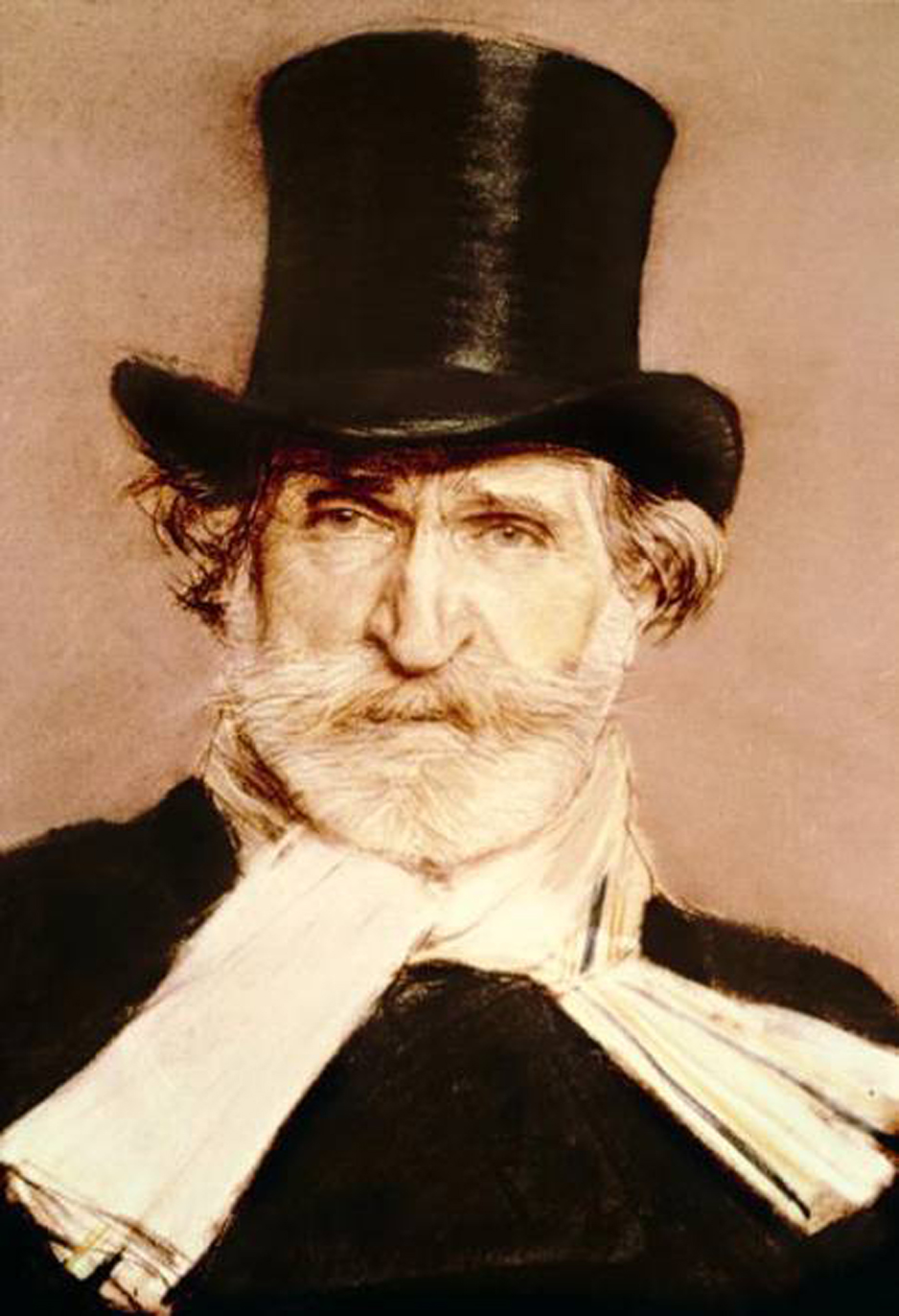 he was baptized on the 11th – in 1813, in Roncole, a small village in the province of Parma. The “national composer” of Italy, Verdi created 25 operas. Not all of them are staged today, but the majority represent the absolute best in the opera repertory. Verdi’s musical genius came into full force when he was approaching 40: just in three years he created three operas which haven’t left the stages of major theaters since their premiers: Rigoletto, first staged in La Fenice in Venice in March of 1851, Il Trovatore, premiered in Rome in 1853, and La Traviata, also in La Fenice in March of 1853. There is so much music in Rigoletto that it could fill several operas: every one of its three acts has something memorable, from Addio, addio and Caro nome in Act I, to Cortigiani, vil razza dannata, Tutte le feste al tempioi and Sì! Vendetta, tremenda vendetta! in Act II, to the ever popular La donna è mobile and the famous quartet Bella figlia dell’amore in Act III and so much more. A fitting tribute to Verdi would be to play the complete Rigoletto, but of course it’s not practical. Instead, we’ll play two excerpts, first, the duet Tutte le feste al tempio (Each holy day, in church) from Act II, with Maria Callas as Gilda and the great baritone Titto Gobbi as Rigoletto; Tullio Serafin conducting the La Scala orchestra in this 1955 recording (here). Then comes Bella figlia dell’amore, with Luciano Pavarotti, Joan Sutherland, Leo Nucci and Isola Jones. Riccardo Chailly conducts the Metropolitan Opera (here).
he was baptized on the 11th – in 1813, in Roncole, a small village in the province of Parma. The “national composer” of Italy, Verdi created 25 operas. Not all of them are staged today, but the majority represent the absolute best in the opera repertory. Verdi’s musical genius came into full force when he was approaching 40: just in three years he created three operas which haven’t left the stages of major theaters since their premiers: Rigoletto, first staged in La Fenice in Venice in March of 1851, Il Trovatore, premiered in Rome in 1853, and La Traviata, also in La Fenice in March of 1853. There is so much music in Rigoletto that it could fill several operas: every one of its three acts has something memorable, from Addio, addio and Caro nome in Act I, to Cortigiani, vil razza dannata, Tutte le feste al tempioi and Sì! Vendetta, tremenda vendetta! in Act II, to the ever popular La donna è mobile and the famous quartet Bella figlia dell’amore in Act III and so much more. A fitting tribute to Verdi would be to play the complete Rigoletto, but of course it’s not practical. Instead, we’ll play two excerpts, first, the duet Tutte le feste al tempio (Each holy day, in church) from Act II, with Maria Callas as Gilda and the great baritone Titto Gobbi as Rigoletto; Tullio Serafin conducting the La Scala orchestra in this 1955 recording (here). Then comes Bella figlia dell’amore, with Luciano Pavarotti, Joan Sutherland, Leo Nucci and Isola Jones. Riccardo Chailly conducts the Metropolitan Opera (here).
Camille Saint-Saëns was also born on this day, in 1835. A prolific composer, Saint-Saëns lived a long life: he died in 1921, three years after Debussy. While he had major melodic talent, he was a composer of conservative tastes; his music was rather conventional from the beginning; by the end of his life it sounded quite dated. Saint-Saëns wrote in many genres: orchestral music (his Third “Organ” Symphony is still popular), five piano concertos (the Second is regularly performed), three violin concertos, one concerto for the cello, and several operas, one of which, Samson and Dalilah is still staged quite often. We can “compare and contrast” it with Rigoletto: here’s Dalilah’s aria, performed by Maria Callas in 1961, the same Callas as we heard in Tutte le feste. By then her voice was not the same; still, it’s a lovely performance, and so is the music. Georges Prêtre conducts The French National Radio Orchestra.
One of the greatest pianists of his generation, Evgeny Kissin was born on October 10th of 1971 in Moscow. He entered the Gnessin Music School at the age of 6. His first, and, amazingly, only teacher was Anna Kantor. He was 10 when he publicly played his first piano concerto (Mozart’s Twentieth); at the age of 12 he played Chopin’s First and Second concertos at the Great Hall of Moscow Conservatory. In 1988 he famously played Tchaikovsky’s First with Karajan and the Berlin Philharmonic. He made his American debut in 1990, a year later he moved to New York. In the subsequent years he also lived in London and Paris, and, since marrying his childhood friend Karina Arzumanova, he moved to Prague. Here he plays Prokofiev’s Piano Concerto No.2 in G Minor Op.16. Vladimir Ashkenazy conducts the Philharmonia Orchestra.Permalink
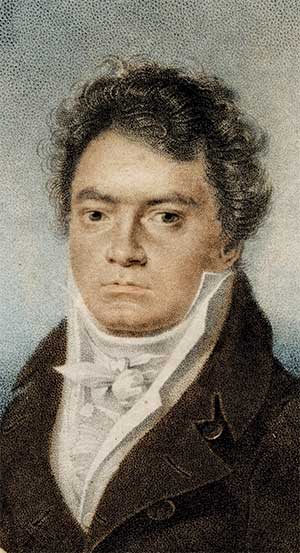 The Eighth Symphony was begun immediately after the completion of the Seventh. Its manuscript, which escaped the fate of that of its predecessor, is dated October 1812, meaning it was completed in a roughly four-month span. This makes it an exception to Beethoven’s usual method of composing, since his symphonies were usually sketched during the summer months, then worked out and put into full score during the winter in Vienna.
The Eighth Symphony was begun immediately after the completion of the Seventh. Its manuscript, which escaped the fate of that of its predecessor, is dated October 1812, meaning it was completed in a roughly four-month span. This makes it an exception to Beethoven’s usual method of composing, since his symphonies were usually sketched during the summer months, then worked out and put into full score during the winter in Vienna.
October 2, 2017. Beethoven Symphony No. 8. This week we’re publishing Joseph DuBose’s article on Symphony no. 8 in F major by Ludwig van Beethoven. And again, as with all other symphonies, the problem is in selecting a performance to illustrate the article: there are too many great ones. We decided on the 1978 recording made by Herbert von Karajan with the Berlin Philharmonic Orchestra. You can listen to it here. The 1st movement is Allegro vivace e con brio (0:01), the 2nd, Allegretto scherzando starts at 9:21, the 3rd, Tempo di menuetto -- at 13:18, and the 4th, Allegro vivace -- at 19:16. ♫
What is truly remarkable of the work is its humorous disposition considering the events that were then taking place in Beethoven’s life. In this manner, it is like the ebullient Second that so completely and effortlessly masked the inner torment that found its outlet in the famous Heiligenstadt Testament. Besides his increasing deafness, Beethoven’s health was already becoming problematic by this point in his life. Yet, of further grief to the composer was a quarrel with his brother Johann. Johann had been living with a woman named Therese Obermeyer, whom Beethoven absolutely loathed and disparagingly nicknamed “Queen of the Night.” Beethoven set out with the singular purpose of putting an end to the relationship. For what reason other than his disdain for Obermeyer is not known, but his actions certainly give credit to Goethe’s description of Beethoven as “an entirely uncontrolled person.” The confrontation between the two brothers was in all probability a mighty din. To Beethoven’s chagrin, Johann emerged the victor when he married Therese Obermeyer on November 8th. Yet, despite this family feud, Beethoven enjoyed pleasant accommodations at his brother’s house, and the surrounding landscape provided him with ample scenery for his many romps through nature. Progress on the Eighth Symphony was unhindered, though some of its passages, no doubt, did not escape Beethoven’s furious temper at this time. (Continue reading here).Permalink
September 25, 2017. Rameau and Shostakovich. It is rather unfortunate that Jean-Philippe Rameau, the great French composer, and Dmitry Shostakovich, one of the most important Soviet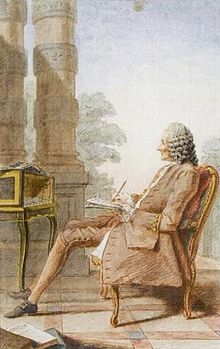 composers, were born on the same day, September 25th, one in 1683, another almost two and a half centuries later, in 1906. So different were the societies into which they were born, the cultures, the prevailing musical styles that it’s almost impossible to write about them in one post. The only thing that their lives had in common is that both lived in absolutist countries: Rameau, under the benign regimes of Louis XIV and his great-grandson, Lois XV, Shostakovich – under the murderous one of Stalin.
composers, were born on the same day, September 25th, one in 1683, another almost two and a half centuries later, in 1906. So different were the societies into which they were born, the cultures, the prevailing musical styles that it’s almost impossible to write about them in one post. The only thing that their lives had in common is that both lived in absolutist countries: Rameau, under the benign regimes of Louis XIV and his great-grandson, Lois XV, Shostakovich – under the murderous one of Stalin.
We know surprisingly little about Rameau’s first 40 years. He was born in Dijon. His father was an organist and gave Jean-Philippe music lessons, starting at an early age. Jean-Philippe studied at the Jesuit Collège des Godrans in Dijon. After finishing school, he went on a short trip to Italy, and stayed in Milan. In 1702, he was appointed a music master at the Cathedral of Notre Dame des Doms in Avignon and stayed there for four years. After that, he worked in several provincial towns, before returning to Dijon in 1709 to take his father’s position as the organist at Notre Dame. He eventually moved to Clermont to work as an organist there. We know that during those years he was already composing, most likely motets, but nothing significant has survived.
In 1722 Rameau moved to Paris, the only place in centralized France where a musician could build a significant career. As a composer, he was practically unknown. His first step was to publish Traité de l'harmonie, a work on music theory, which was soon followed by the Nouveau système de musique théorique, another theoretical work that made him famous not only in France, but in England as well. He continued to compose but mostly for the harpsichord, although he was already interested in writing operas (circumstances wouldn’t allow for that to happen till 1733). In the meantime, he was earning his living by teaching. In 1732, he convinced the playwright Simon-Joseph Pellegrin to create a libretto for him. Based on Racine’s Phèdre, it was called Hippolyte et Aricie. The opera premiered on October 1st of 1733 in the theatre of Palais-Royal. André Campra, a major opera composer of the time, said, upon listening to Hippolyte: “There is enough music in this opera to make ten of them; this man will eclipse us all.” At the time, Rameau was 50 and at the beginning of his real career, as a tremendously productive opera composer. Working almost exclusively in that genre, he wrote 32 operas. One of the most successful was Dardanus, but not till Rameau rewrote almost half of it: the first edition was premiered in 1739 and was criticized for a weak libretto; the second, the one that is being staged these days, was created five years later, in 1744. Here’s a suite based on Dardanus. Tafelmusic orchestra is conducted by Jeanne Lamon. And here, to give the impression of the vocal part, is the aria Lieux funestes from the 4th act of the opera. The Scottish tenor Paul Agnew is Dardanus; Antony Walker conducts the Orchestra of the Antipodes.
Even though we have little space left, we can’t not mention Dmitry Shostakovich. In his symphonies, Shostakovich felt obligated to toe the line of Socialist Realism; with his phenomenal ear, he picked up the style and the melodies that, he hoped, would embody Soviet realities and please the Party cultural inquisitors. In most cases it worked, in some he was severely criticized. The smaller form, quartets, for example, were not so visible, and here Shostakovich could allow himself to be less political. Here’s one, Quartet no. 3 in F Major, op. 73. It’s performed by the Fitzwilliam String Quartet.Permalink